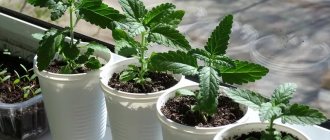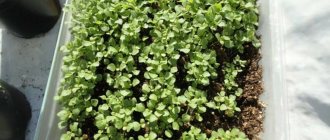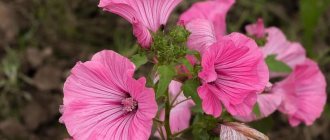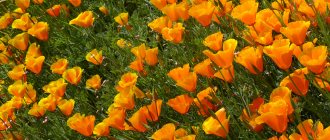The flowers, familiar to everyone since childhood, owe their name to their external resemblance to miniature bells. Even in Latin they are officially called “Campanula” - bell. We also often affectionately call them bells, chenilles, and chebotki. Like many flowers, they are sung in beautiful legends.
According to one of them, the first church bell was created in the image of this tender, fragile gift of nature. It was after their quiet ringing was heard after the wind blew that the priest ordered a copper mold to be cast for the temple in the image and likeness of a flower. Even today there is a belief that their quiet crystal ringing can be heard on Ivan Kupala. Another legend tells about the growth of bells on the site of the scattered fragments of the mirror of the goddess Venus.
Many peoples perceive the bell as a good talisman, capable of driving away all evil spirits with its ringing. It is considered a symbol of faith, joy, openness, increase in wisdom, and harmony between Man and Heaven.
There is a sign that bells dream of good news, good changes in your personal life, and a warning against rash actions. And the enthusiastic praise of this flower by poets and artists deserves a separate discussion.
The desire to get an armful of bells is indomitable, but the picked bells quickly fade... In order to admire them for a long time, it is better to grow them in nature or in your apartment. We invite you to get acquainted with the characteristics of flowers and methods of growing them more specifically.
How to grow a medium bell from seeds on a plot
It’s hard to imagine a plot without bells; these are one of the most common beautifully flowering garden plants.
Bells of different varieties and types look great in any flower bed and among plants on an alpine hill; tall bells are suitable for cutting and used for making bouquets. You can select bells by type, color and shape of the flower, by height of growth; there are quite a lot of hybrid species, but do not forget about the traditional varieties of bells. They have proven themselves excellent in our areas. Plants of this type can be annual, perennial and biennial.
Among the numerous flowering callas, a group of biennials stands out. It is very convenient for gardeners to plant biennials in the garden; they are sown one summer and bloom well the next year. Often, biennials do not need to be replanted annually, like annual flowering plants; they reproduce by self-sowing without much hassle.
One of the representatives of biennials is the middle bell or campanula; they stand out for their originality and are often used for planting in groups with annuals and as single plantings on lawns. Tall varieties of bluebells are excellent for planting on the lawn and also in flower beds for cutting bouquets. Low-growing varieties of campanula are used for planting in rock gardens and borders.
The most widespread are the biennial bell - medium, perennial peach-leaved, broad-leaved and Carpathian bells.
Medium bell
It is grown and propagated through seedlings; perennial species are propagated by dividing the bush. Some people think that this is a perennial plant, but the erroneous impression is due to the fact that the middle bell drops ripened seeds into the soil and they sprout and bloom the next year. This is how natural renewal of crops occurs. Therefore, it is better not to dig up the place where beautiful biennial bells grew, especially the “Cup and Saucer” variety, and not to sow them with other plants.
Growing a medium bell is best done with seedlings. And you need to start growing it in March. It is better to sow bellflower as a biennial crop very early in the spring, so that the plants have time to grow and get stronger before winter; the seeds are sown in boxes. The boxes must be covered with film and also shaded with paper or cloth; in the dark, the seeds will germinate and sprout faster; this is a feature of growing bells from seeds.
The seedlings are picked and transplanted to permanent locations by the end of summer. Bells bloom next year. If sowing is done later, the bells may begin to bloom only in the third year after planting. Before flowering, the bell will only have a rosette consisting of lanceolate leaves; it must be protected and watered regularly, and sprinkled with dry leaves or large sawdust for the winter. At the same time, creating a slight elevation so that the roots do not get wet during winter thaws.
The average bell has an erect stem and on it are large “glasses” of flowers of various colors. Flowers can be simple, double or double, creating a “cup and saucer”. The bell looks very original during flowering. Flowering begins in June and continues until September. The middle bell is one of the most popular biennials among summer residents and gardeners and the most common “cup and saucer” variety recently.
A novelty in recent years, the medium bell “Cup and Saucer” received its name for the shape of the flower. The height of the peduncle is up to 70-80cm, the inflorescence is powerful with up to 40 flowers. Reproduction and care, as for the average bell.
Preparing for winter
One- and two-year-olds do not need preparation for wintering. But perennial plants need to be properly prepared for exposure to low temperatures. In the third ten days of September, all shoots must be cut to the lowest point. Frost-resistant varieties will easily survive even a cold winter. And southern, heat-loving varieties need to be protected. To do this, after pruning, they are sprinkled with dry leaves or spruce branches on top.
Tall plants are sprinkled on top with a dry mixture of peat and humus. The thickness of the layer must be at least 30 centimeters.
Thus, bells are unpretentious flowers to care for. They are used to create bright compositions in landscape design. Despite their ease of care, bells are an excellent decoration for a front garden, flower bed or vegetable garden.
Sowing bells with seeds - what you need to know
To grow a beautiful flower in the garden or front garden, you will need to decide on the type and variety. Additionally, calculate some nuances for cultivation and care. The requirements are standard.
With properly planned actions, a flower will become an ornament, a decoration, and a means to eliminate a bad mood.
The best varieties for sowing
It is recommended to start planning by choosing a variety and type. In total, more than 300 types are known, but each of them can grow in certain climate conditions.
Most develop well if climatic conditions are characterized as moderate. Able to develop calmly:
- European countries;
- Central Asia;
- North America;
- Siberia;
- in the Caucasus.
The noble flower has taken root well throughout Russia (more than 150 species). Bells are divided according to the height of the stem, the order of leaves, and the shape of the petals. So there are three types:
- with a height of more than 1 meter - tall;
- if the flower is less than 1 m - low-growing;
- up to 20 cm - short.
There are also biennial, annual and perennial types of bellflower.
| Annuals | Two-year-olds | Perennial | |||
| Plants prefer southern regions for germination. Rarely take root in places with temperate or cool climates. | Forked. Description: height 15-20 cm. Abundant flowering. Pale purple flowers. | Two-year-old varieties can thrive in all types of soil. Difficulties may arise in the northern regions. Prefers warm regions. | Bearded hybrid species. Height: minimum 3 cm, maximum 30 cm. Color light blue. Shape: glass-shaped. | The varieties are distinguished by strong immunity. Develop well on mountain slopes and northern regions | Carpathian view. Reaches 30 cm. Colors: blue, white, purple. Hybrid form. |
| Kashmiri. Height: 5-8 cm. Flowers are small, purple. | Hoffman flower. It is distinguished by strong branching. Grows up to 45-50 cm. Color: white or cream flowers. | Gargan bells. Special flowers: round shape, three-toothed petals. Colored blue, pale lavender and white | |||
| Long-columnar bell. Strongly branched, abundant flowering. Height 45-50 cm | Thyrsoid (pale yellow) and spicate (bright purple) appearance. Inflorescence shape: funnel-shaped | Spiral-leaved. It grows to a maximum of 15 cm. The plant is creeping in white, blue or light blue. | |||
| Mirror of Venus. Grows up to 35 cm. Flower shape: saucer-shaped. The color is blue, lilac tint with a white center. | Large bell. Blooms late (late June-July). Height is more than a meter. There are about 7 flowers on the corolla | Chamisso. The variety is miniature (4-5 cm). The color is different from the majority of species: bluish-violet with white tints. |
In what month is it sown?
Before planting a bell, the gardener must take into account the region of growth and the time of warming. The recommended sowing time is the last month of spring.
An important point is the coordination of seed sowing according to the lunar calendar.
Since favorable days for work change annually, it is worth carrying out and planning procedures for caring for and growing a bell on the waxing moon (from the 3rd to the 14th lunar day).
Description
It grows on rocky, rocky slopes in southern Europe, especially southwestern France and southern Italy. Due to its large flowers, it is grown almost all over the world. Americans are especially fond of bells. Height , 60-90 cm. Flowering period , June-July. You can prolong flowering by regularly removing spent flowers to prevent the plant from setting seeds. Flower color , pink, lavender, violet blue, white, many varieties of different shades of blue. Place , in completely sunny places it blooms more massively; in partial shade the flowering is not spectacular, but lasts longer. Frost resistance , bellflower in the colder part of our country is not fully frost-resistant, it is better to cover the growing area with compost and mix it with soil in the spring.
How to sow bellflower seedlings correctly: main steps
Planting bellflower seedlings at home requires compliance with certain preparatory measures. Let's look at them in more detail.
Seed preparation
Bluebell seeds germinate normally without preparation. In addition, after soaking they remain wet, making them very difficult to sow. If you still want to increase germination, you can treat them in a solution of a growth stimulant drug, and then filter through a thick cloth and allow to dry before sowing.
Soil preparation
In nature, in open ground, bells grow well on rocky, calcareous soils. However, when growing seedlings of this crop at home, light, loose, moderately nutritious, neutral or slightly alkaline soil is ideal.
Without any obstacles, you can plant bell seeds in ordinary universal soil for flower seedlings. But before sowing, you should definitely add a loosening element to the soil, which will improve the structure and air and water permeability. For example, sand, vermiculite, perlite (as in the photo). You need to mix in the ratio of 3 parts earth and 1 part baking powder.
Selection of capacity
The most suitable option for planting bellflower seedlings is a wide and shallow container, the optimal height of which is 7 centimeters. It is not recommended to choose bowls that are too deep. But as for individual cups, cassettes, pots, sowing crops in them is not very convenient, because the seeds are very small.
The seedling container must have drainage holes to remove excess moisture. If they are not there, then you need to do it yourself, for example, with a soldering iron, nail, scissors.
Before use, it is recommended to disinfect the seedling containers, for example, by spilling them with a dark solution of potassium permanganate.
Master class on planting
As they say, it is easier to see once than to hear a hundred times. Therefore, we provide you with step-by-step photo instructions for sowing bellflower seeds for seedlings:
1) Place drainage material in the container.
For example, perlite, expanded clay, any small stones. A one and a half centimeter layer is enough.
2) Fill the container with soil, leaving a small distance to the edges (2-3 cm).
Thus, when the first shoots sprout, they will not immediately rest against the lid or film.
3) Moisten the soil with clean water.
4) Sow.
For this reason, it is convenient to sow them with sand. To do this, pour a small amount of clean calcined river sand into a shallow bowl and mix well with the seeds.
Plant the bell seedlings by evenly distributing the seeds with sand over the surface of the soil.5) Water the soil with the seeds.
6) Cover the container with a lid or film to create a mini-greenhouse.
As noted above, the seeds of this crop need light to germinate, so the covering material must be transparent.
7) Label the container with future seedlings in some convenient way.
Sowing work
The process of sowing seeds is not complicated; you should follow the instructions:
- A drainage layer 1 cm thick is placed at the bottom of the container. Perlite or expanded clay can be used as drainage.
- Fill the container with soil. You should not fill it to the brim; it is better to leave 1-2 cm free to the top.
- The soil is moistened with warm, settled water.
- Then surface landing is carried out. The seeds are sown on the ground and lightly pressed down.
- Spray the soil using a spray bottle.
- Cover the top with a transparent lid or cling film. This creates a greenhouse effect.
The optimal air temperature in the room with containers is +20-22°C.
The seeds should be kept under the film until the first shoots. In order for the plant to receive enough oxygen and light, it is necessary to remove the covering material for 30 minutes once a day.
Growing bells from seeds when to plant
There are two ways to grow bluebells from seeds. This is done in seedlings and not. But if you grow without seedlings, the flowers will appear only after a year.
Sowing in the ground
Planting is allowed in the first months of spring. However, before this it is necessary to carry out cold stratification. The seeds in the bag are mixed with raw sand and placed inside the refrigerator in the place for vegetables.
Stratification can also be done naturally. To do this, you need to plant the seeds in the ground in the fall. Winter will serve as a hardening for the plant. And in the spring the sprouts will all sprout together.
It is not worth deepening the seeds lower than 2 cm. Indeed, due to their miniature size, it will be extremely difficult for them to break through the soil. You also need to plant not very often, about 2-3 centimeters apart
After the sprouts appear, it is important to thin them out to 4-5 cm. When the flower grows, plant them 20-30 centimeters apart
The distance depends on the variety.
Medium bell
Growing seedlings
If you want to see flowers in the first year, then you need to make seedlings. The seeds are quite miniature in size. They should be scattered over soil that is light, loose and through which water easily passes. Before planting, the soil needs to be additionally moistened. For this, a mixture of humus, turf soil, and coarse sand in proportions of 3:6:1 is usually used. Afterwards, this area is covered with film and the temperature should remain within 18 degrees Celsius. After 2-3 weeks, sprouts will appear.
When the seeds have sprouted, the container must be moved to a location where the sun will not shine directly. The film is removed and the sprouts are then cared for. They need to be watered and the soil around them loosened when it is already a little dry at the top. A month later, when there are already 2-4 leaves, the seedlings are transferred to a larger container, seating them 10 cm apart. They can also simply be placed in different cups. After a week-long stay of the young plant in such conditions, it is allowed to add a weak fertilizer (liquid composition).
Bluebell seedlings
Planting bells in the ground
When the end of spring approaches and summer begins, seedlings can be transferred to open ground. Now we will briefly tell you how to plant bells. Most of them love light. Those that do not tolerate it very well are distinguished by their dark green leaves. But there are quite a few of them. All of them do not tolerate drafts well. Such plants need a lot of nutrients and enough moisture. In order for all this to be sufficient, it is better to plant not near trees and shrubs. Those species whose height is low should be planted 10-15 centimeters apart from each other. Average height - 20-30 centimeters. Large - 0.4-0.5 meters. When the flower has already been planted, the soil within the radius must be compacted and watered abundantly. If the bells have been properly cared for and planted in open ground, they will be able to please the owner’s eye for a long time.
Reproduction methods
Bluebell Cup and saucer reproduces in several ways:
- Seminal. Material collected at home in early autumn does not fully guarantee the repetition of the varietal characteristics of the mother plant. Seeds purchased in specialized stores allow you to completely recreate the individual characteristics of a variety.
- Cuttings (allows you to preserve the varietal identity) - propagation by separating a cutting with three healthy internodes from 2-year-old plants.
- Dividing the bush (allows for the transfer of varietal characteristics) - propagation by dividing the root system of an adult crop into 2-3 parts containing several viable stem buds.
The seed method of planting seedlings is most often used by gardeners to propagate medium-sized flowers “Chinese service”
The bell is medium. Cup and saucer. Growing from seeds.
Bells are very beautiful flowers. They plant themselves on my site. Regular. Almost weedy. But I don’t have large bells of various colors. Why not plant them? Let them grow. There's a lot of space. I bought seeds. These are the ones in the photo on the right. And as always, I’ll start with theory.
Medium bell - C. medium L.
Homeland - Southwestern Europe, Asia.
A biennial plant in cultivation, sometimes grown as a perennial due to natural renewal. It is distinguished by an erect, stiff-haired stem 50-100 cm tall. The flowers are goblet-bell-ringed, blue, light blue, white or pink, simple or double, up to 7 cm long, collected in a pyramidal inflorescence. Blooms from June to September. Fruits in August-September. The seeds are small, gray-brown. There are 4500 seeds in 1 g. In culture since 1578. Bell Cup and saucer two years old. If you grow it through seedlings, it will bloom in the year of sowing, but if you sow it directly in open ground, you will be able to admire the flowering only in the next year.
- Location
The plant is light-loving, cold-resistant and moisture-loving. Prefers deep-cultivated, rich soil in a sunny location. The bell does not tolerate acidic soils and stagnant water. In damp areas, plants die out in winter. For 1 sq. m of clay soils, 15 kg of humus or compost are added for digging, loamy soils - 19 kg of humus or compost.
The flowering of this bell is very rich, the plants are completely covered with large bells, which makes a completely irresistible impression. Planted singly or in groups against the backdrop of a lawn, in prefabricated flower beds or on ridges, and used as a cut flower. It also looks very impressive in bouquets. Cut flowers are stored in water for 10 - 12 days.
Difficulties In addition to the fact that bells need good soil for excellent flowering, bells are demanding when it comes to growing conditions. They sprout in the dark. Seeds do not germinate in light. And one more condition. Winter shelter. The bell requires shelter for the winter. Rosettes of leaves that form by the autumn of the first year need to be covered with dry peat or fallen dry leaves; covering material is also well suited for this.
GROWING FROM SEEDS
You can, of course, plant the seeds directly into the ground. But then the flowers will appear only next year. Moreover, the bell is especially sensitive to failure to meet deadlines for work. If the rosettes of basal leaves are underdeveloped, the plants may not bloom in the second year, but there is no need to throw them away - flowering will occur in the third year. In order for the bluebell to pamper us with flowers in the first year, we need to grow it using seedlings. Sowing bellflower seeds for seedlings in March - early April, for flowering in the summer of the same year. Optimal soil temperature for seed germination: + 20 0C. The prepared soil in the seedling box is watered before sowing. The bell seeds are lightly sprinkled with fine river sand on top, then the container with the seeds must be placed in a plastic bag to create a greenhouse, and be sure to shade the crops. This is the difficulty - the bell does not germinate in the light. Bellflower crops are often sprayed and kept under black film or covering material all the time. Shoots appear in about two weeks. It will take another 15 - 20 days for the bell seedlings to get stronger. Then comes the picking phase. Bellflower seedlings are planted according to a 10 x 15 cm pattern. The transplanted plants are shaded again until they are fully established, for about a week. Seedling care is usual.
Looking through the literature about bells, I saw that bells can be taken from cuttings! It is done like this: Sometimes they practice propagation of the middle bell by cuttings. They are cut in the spring of the second year of cultivation. The rooting scheme is standard: a cutting with one or two internodes with cut leaves is planted in moist soil with the addition of sand, the other two internodes are left above the soil surface; kept in a moist, warm environment under a film or jar with a small air flow. LANDING INTO THE GROUND
Planting homemade bell seedlings in a permanent place: May - June. If the seeds were germinated in open ground, the seedlings are planted in a permanent place in August. When planting bell seedlings, you should adhere to a planting pattern in which the optimal distance between plants is 30 x 40 cm.
MEDIUM BELL (CAMPANULA) fam. Campanulaceae
Varieties
- Mixture of colors - height 80 cm. Large, double, goblet-bell-shaped flowers of various colors, 6-8 cm in diameter. Blooms June-September. Biennial.
- Terry mixture of colors - height 80 cm. Double flowers with a diameter of 6-8 cm, collected in large pyramidal inflorescences. Cut flowers remain fresh for up to 2 weeks.
- Cup and saucer is a popular variety of the medium bluebell. Height 80 cm. The calyx of the flower is of an original shape, reminiscent of a cup standing on a saucer. Mix of colors.
- Carmine rose - height 80 cm. The flowers are carmine pink, 6-8 cm in diameter, collected in large inflorescences. Blooms June-September.
- Snezhana - height 80 cm. Blooms with snow-white flowers with diameters of 6-8 cm.
- Raspberry ringing - height 75 cm. Double flowers, a mixture of colors.
- Campana white - height 75-85 cm, grown in a greenhouse or open ground. The flowers are snow-white.
- Rosea - height 80 cm, with pink flowers.
- Cerulea is a variety with rich purple flowers. Height 80 cm
- Cheerful gramophones - a mixture of colors, distinguished by an erect, stiff-haired stem.
- Dreaming is a variety with an erect, stiff-haired stem, 80 cm high. The leaves are oblong-oval, the stems are ovate-lanceolate. The flowers are large, pink, 4-5 cm in diameter, collected in pyramidal inflorescences, 30-50 cm long. Blooms June-July.
- Alba is a variety with white pyramidal inflorescences that resemble an ice cream cone.
- Cantenberry bells is a variety with pyramidal inflorescences. Biennial 80 cm high. Mix of colors
- Crimson rose is a biennial with pink inflorescences. Flowering period June-July. Height 70-80.
- Rhapsody is a mixture with double inflorescences of various colors, white, pink, lilac and purple.
The middle bell is not particularly picky about the ground. Prefers permeable soil that is fairly fertile and retains moisture well. There will be more inflorescences and larger flowers. On weak soils, to obtain lush flowering, in the spring add a large dose of compost and a multi-component dose of fertilizer.
In the best soils, especially those planted in partial shade, the plants will be taller; in the event of heavy rain or strong winds, it is worth protecting from bending.
When buying seeds, you should pay attention to the height of the plants; low varieties can be successfully planted in pots (standing on the ground) as the central element of the composition, or the entire pot can be planted with a bell. But they are completely unsuitable for any type of balcony boxes, they are too high.
If the summer is rainier, double varieties will suffer more than regular varieties.
Sowing seeds in open ground
The plant is unpretentious: therefore, if the climate is not too harsh, you can plant directly with seeds in open ground. Usually, growing from seeds in open ground begins in mid-autumn or in May.
However, sowing in autumn is more preferable, since under a layer of winter snow the seeds are naturally stratified and hardened.
Planting is done in a garden bed in prepared soil. The composition of the soil should be as follows:
- turf land;
- river sand;
- old peat (not greasy).
There is no need to fertilize the garden bed with organic matter before planting.
The seeds are laid directly on top of the soil and are not buried. Since the seeds are miniature in size, deepening them can make it difficult for them to germinate. It is recommended, however, to sprinkle sand on top of the crops.
When planting in spring, the first shoots can be expected a couple of weeks after planting. Autumn planting even sprouts next spring - about 10-14 days after the snow melts and the ground thaws.
After three full leaves appear on the seedlings, the plants dive. It is necessary to leave the strongest and healthiest shoots in the garden.
Let's get acquainted with the features of caring for the Carpathian bell growing in the open air.
The soil in the garden bed is usually moistened only during the summer drought. When watering, use a bucket of water per 1 m2 of soil. After the moistening procedure, it is recommended to loosen the soil and remove weeds from it.
Important: in the spring you don’t have to water the bells at all, since the plant will get enough moisture from the melted snow. The bell is fed twice during the growing season.
In the spring, nitrogenous fertilizers are applied so that the green part of the plant forms faster. The second time, fertilizing is applied at the beginning of flowering. Compositions containing potassium and phosphorus are used, which will help produce more buds
The bluebell is fed twice during the growing season. In the spring, nitrogenous fertilizers are applied so that the green part of the plant forms faster. The second time, fertilizing is applied at the beginning of flowering. Compositions containing potassium and phosphorus are used, which will help produce more buds.
You cannot be too zealous with fertilizing, as otherwise there is likely to be excessive formation of green mass and poor flowering against this background.
This procedure is carried out the next year after planting. Faded inflorescences are cut off. The procedure allows:
- prevent spontaneous self-seeding;
- preserve the decorativeness of the flowerbed;
- provide the “living” part of the plant with sufficient nutrients.
Attention: when trimming leaves, do not forget to collect the fruit boxes first. Otherwise, self-seeding cannot be avoided
Every spring, in addition, it is necessary to inspect the plants and remove frozen, weak and diseased specimens.
And in order to make the flowering period longer, experienced gardeners proceed as follows: when the first wave comes to an end, they cut the flower stalks short. And after about a month, the Carpathian bell blooms actively and luxuriantly again.
Mulching
The procedure is carried out after watering and allows you to provide the plant’s roots with a sufficient amount of moisture. In addition, a layer of organic mulch also protects against weeds. Note that when growing bells on alpine hills or in other rocky landscapes, mulching is not performed.
Rules for caring for and growing in the garden
A cup and saucer will grow even with minimal supervision, but abundant, long-term flowering is only possible if certain conditions are created. The bell needs watering, loosening the soil, and fertilizing.
The Chinese set does not like constant abundant soil moisture. The beds sown with seeds are sprayed with a spray bottle. Regular watering during the formation of buds is considered mandatory. In dry, hot weather, flower beds should be irrigated as the soil dries out. Small and sparse flowers are a sign of lack of moisture. It is better to store water for irrigation in containers or collect rainwater.
The rest of the time, the bells can withstand slight drought quite steadfastly, and often die from waterlogging. At the end of the summer season, during the rainy season, the plants stop being watered, otherwise the root system may rot.
In well-prepared soil, seedlings appear friendly, strong and do not require additional feeding. Bells are fertilized in the second year of life. The first time is in early spring, when the protective layer of branches or foliage is removed from the rosettes. The solution is made as follows: 30-40 g of ammonium nitrate per 10 liters of water, water the beds and flower beds.
During the formation of buds, the bells are fed a second time, using an infusion of weeds and ash. The following mineral fertilizers are used:
- Kemira (500 g per 1 sq. m.);
- Agricola (50 ml per 10 liters of water);
- Pokon (100 ml per 10 liters of water).
After watering, the soil in the root space of the bells must be loosened. At the same time, weeds are removed.
Rotted manure and compost are often used as mulch, but peat is undesirable because it acidifies the soil. Organic matter also plays the role of fertilizer on poor soils.
Bells do not need to be pinched. During flowering, flowers that have wilted are pinched and removed so that the plant does not waste energy on ripening the seeds. In the autumn of the first year, mandatory pruning of leaves is carried out.
If the plant becomes drooping and yellowish, the stems and leaves lose their elasticity with proper care, a good solution would be to transplant to another location or drain the soil. Replanting is carried out in case of soil depletion or changes in relief conditions.
The bell is dug up along with a lump of earth, preserving the root system from damage as much as possible. The planting hole should be larger than the root ball, and for better rooting it is necessary to regularly spray the leaves during the adaptation period.
Bluebell Cup and Saucer needs shelter for the winter only in areas with harsh winters. You should not insulate a plant planted in the southern region. With the onset of spring, the roots may dry out and die from excess heat. In areas with a temperate climate, bells are insulated in the fall with sawdust and branches. A layer of snow on top will help you survive the winter without consequences.
Possible problems
If you do not follow the basic rules for caring for garden campanula, some problems may arise:
- for planting you need to choose a well-lit area, otherwise the growth of the plant slows down and the stems stretch;
- the soil must be drained so that moisture does not stagnate and the roots do not rot;
- it is necessary to water the bushes in a timely manner so that the soil does not dry out and the plant does not suffer from water deficiency;
- the soil needs to be loosened, the root system needs oxygen.
Carpathian bellflower - planting
The unpretentiousness of the Carpathian bell attracts many gardeners who want to decorate their plot or garden with beautiful flowers with abundant and long-lasting flowering. The plant can be grown both on the sunny side of the garden and in partial shade. When choosing a suitable planting site, you should remember that this perennial flower grows well in one place, without transplanting for more than 5 years. For a fragile plant, you should choose an area without drafts.
The best soil for growing a plant is a fertile, loose substrate with excellent drainage and a neutral or slightly alkaline reaction. Heavy and loamy soils, where moisture often stagnates or groundwater flows through, are not suitable for planting. The bell dies from excess moisture, which leads to rotting of the root system. Therefore, for planting flowers, you should choose flower beds located on hills or rocky areas. You can plant bells in open ground only after deep digging of the soil in the spring. If the soils are heavy, it is necessary to add river sand and humus; in poor soils, turf soil and complex fertilizers are added, as well as manure and peat, since these fertilizers can provoke the development of a fungal disease.
How to grow Carpathian bell from seeds
Spring planting of bell seeds in open ground is the most popular way of growing a flower for the southern regions, where in May the soil is already sufficiently warmed up. 2 weeks after planting, you can already observe the first shoots. After the first leaves appear on the sprouts, the bushes are picked and replanted at a distance of 10 cm from each other. You can sow seeds in the fall; the optimal month for sowing is mid-October. The first young shoots appear after the snow melts, when the soil warms up. The seeds of the Carpathian bell are very small; it is enough to spread them on the surface of loose soil and sprinkle them with sand. Under optimal conditions and compliance with all requirements for soil composition, 1 gram of seeds gives excellent germination.
Carpathian bellflower: growing seedlings
There is another planting method, but it is long and labor-intensive; this is planting seed for seedlings in boxes. You can sow seeds as early as February-March.
Stages of work:
For seedlings, prepare special boxes or containers with nutritious soil mixture. Ready-made soil intended for growing seedlings can be purchased in specialized stores or prepared independently. To do this, mix turf soil, humus and river sand, maintaining a ratio of 6:3:1. Seeds are sown in a moistened substrate. It is enough to scatter small seeds on the surface of the soil and lightly press them down without compacting them or covering them with a layer of soil. Containers with planted seeds are covered with film or glass and placed in a warm, well-lit room or windowsill. For 2 weeks, the film must be opened slightly every day to ventilate and moisten the soil using a spray bottle. It is also important to remove condensation that forms on the inside of the film or glass.
The first small shoots appear in the second or third week after they are sown in the ground. Seedlings grow slowly and require additional lighting. After the first leaves appear, the seedlings are picked and planted in cups of 2-3 bushes. In May, Carpathian bellflower seedlings are ready for planting in open ground.
Wintering
After flowering has finished and the seeds have been collected, the bell bush should be pruned at the root. To avoid death from frost, the plant should be covered with a layer of compost or peat up to 20 cm high. In cold regions, the plant should be additionally covered with dry leaves or spruce branches, but agrofibre can also be used. Manure and humus for winter shelter can only be used on depleted soils in order to avoid an excess of nitrogen in the spring.
If you plan to use the seeds, you need to collect them before they are fully ripe, as they begin to open and fall off. After collecting, they need to be dried and the seeds removed, which should be stored in a dry and warm place. They remain viable for up to 4 years.











